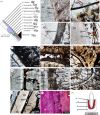Dental ontogeny in extinct synapsids reveals a complex evolutionary history of the mammalian tooth attachment system
- PMID: 30404877
- PMCID: PMC6235047
- DOI: 10.1098/rspb.2018.1792
Dental ontogeny in extinct synapsids reveals a complex evolutionary history of the mammalian tooth attachment system
Abstract
The mammalian dentition is uniquely characterized by a combination of precise occlusion, permanent adult teeth and a unique tooth attachment system. Unlike the ankylosed teeth in most reptiles, mammal teeth are supported by a ligamentous tissue that suspends each tooth in its socket, providing flexible and compliant tooth attachment that prolongs the life of each tooth and maintains occlusal relationships. Here we investigate dental ontogeny through histological examination of a wide range of extinct synapsid lineages to assess whether the ligamentous tooth attachment system is unique to mammals and to determine how it evolved. This study shows for the first time that the ligamentous tooth attachment system is not unique to crown mammals within Synapsida, having arisen in several non-mammalian therapsid clades as a result of neoteny and progenesis in dental ontogeny. Mammalian tooth attachment is here re-interpreted as a paedomorphic condition relative to the ancestral synapsid form of tooth attachment.
Keywords: ankylosis; dental histology; paedomorphosis; pelycosaur; therapsid.
© 2018 The Author(s).
Conflict of interest statement
The authors have no competing interests to declare.
Figures




Similar articles
-
Evolution of tooth morphological complexity and its association with the position of tooth eruption in the jaw in non-mammalian synapsids.PeerJ. 2024 Aug 12;12:e17784. doi: 10.7717/peerj.17784. eCollection 2024. PeerJ. 2024. PMID: 39148681 Free PMC article.
-
Mosasaurs and snakes have a periodontal ligament: timing and extent of calcification, not tissue complexity, determines tooth attachment mode in reptiles.J Anat. 2017 Dec;231(6):869-885. doi: 10.1111/joa.12686. Epub 2017 Sep 12. J Anat. 2017. PMID: 28901023 Free PMC article.
-
Ontogeny reveals function and evolution of the hadrosaurid dinosaur dental battery.BMC Evol Biol. 2016 Jul 28;16:152. doi: 10.1186/s12862-016-0721-1. BMC Evol Biol. 2016. PMID: 27465802 Free PMC article.
-
Phylogenetic memory of developing mammalian dentition.J Exp Zool B Mol Dev Evol. 2006 May 15;306(3):234-50. doi: 10.1002/jez.b.21093. J Exp Zool B Mol Dev Evol. 2006. PMID: 16463376 Review.
-
Developmental pathways of periodontal tissue regeneration: Developmental diversities of tooth morphogenesis do also map capacity of periodontal tissue regeneration?J Periodontal Res. 2019 Feb;54(1):10-26. doi: 10.1111/jre.12596. Epub 2018 Sep 12. J Periodontal Res. 2019. PMID: 30207395 Review.
Cited by
-
Feeding experiments on Vittina turrita (Mollusca, Gastropoda, Neritidae) reveal tooth contact areas and bent radular shape during foraging.Sci Rep. 2021 May 5;11(1):9556. doi: 10.1038/s41598-021-88953-7. Sci Rep. 2021. PMID: 33953284 Free PMC article.
-
Craniodental anatomy in Permian-Jurassic Cynodontia and Mammaliaformes (Synapsida, Therapsida) as a gateway to defining mammalian soft tissue and behavioural traits.Philos Trans R Soc Lond B Biol Sci. 2023 Jul 3;378(1880):20220084. doi: 10.1098/rstb.2022.0084. Epub 2023 May 15. Philos Trans R Soc Lond B Biol Sci. 2023. PMID: 37183903 Free PMC article. Review.
-
Plicidentine in the oral fangs of parrotfish (Scarinae, Labriformes).J Anat. 2022 Sep;241(3):601-615. doi: 10.1111/joa.13673. Epub 2022 May 4. J Anat. 2022. PMID: 35506616 Free PMC article.
-
Tooth replacement patterns in the Early Triassic epicynodont Galesaurus planiceps (Therapsida, Cynodontia).PLoS One. 2020 Dec 30;15(12):e0243985. doi: 10.1371/journal.pone.0243985. eCollection 2020. PLoS One. 2020. PMID: 33378326 Free PMC article.
-
Palaeohistology reveals an unusual periodontium and tooth implantation in a filter-feeding pterodactyloid pterosaur, Pterodaustro guinazui, from the Lower Cretaceous of Argentina.J Anat. 2023 Oct;243(4):579-589. doi: 10.1111/joa.13878. Epub 2023 Apr 14. J Anat. 2023. PMID: 37059589 Free PMC article.
References
-
- Weller JM. 1968. Evolution of mammalian teeth. J. Paleontol. 42, 268–290.
-
- Kemp TS. 1982. Mammal-like reptiles and the origin of mammals. London, UK: Academic Press Inc.
-
- Sidor CA, Hopson JA. 1998. Ghost lineages and ‘mammalness’: assessing the temporal pattern of character acquisition in the Synapsida. Paleobiol. 24, 254–273.
Publication types
MeSH terms
Associated data
LinkOut - more resources
Full Text Sources
Other Literature Sources

